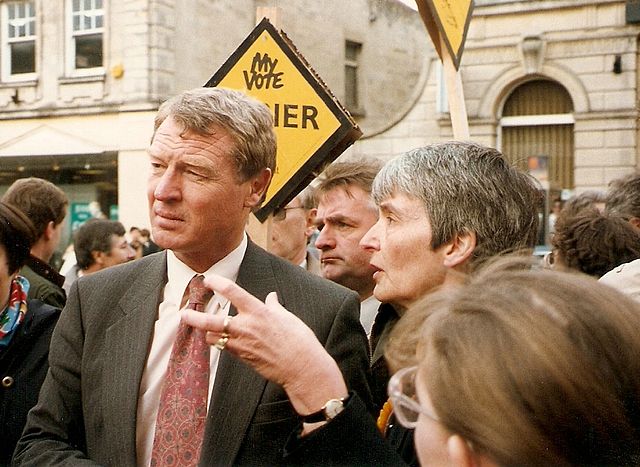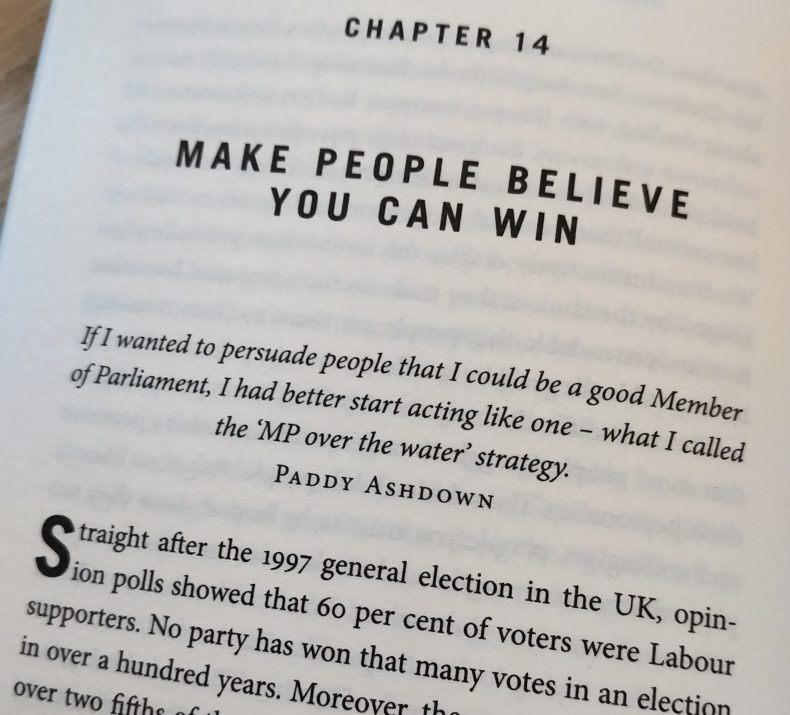Paddy Ashdown’s eight steps to winning a Parliamentary constituency

In December 1976 Paddy Ashdown put to the local party in Yeovil a plan for winning the constituency. He had just been selected as their Parliamentary candidate, but the party was third at almost every election. Yet in less than a decade he was the MP.
Nearly fifty years on, it still reads as a pretty good plan, so here it is once again:
1. We should adopt a three-election strategy and should plan on that basis that I would probably not be in a position to mount a genuine challenge for the seat until my third attempt. [It took him two rather than three attempts as it turned out.]
2. I would need to stay full-time in the constituency. So I had to get a job locally and could not afford to get distracted by anything other than the single task of winning Yeovil (i.e. I could not afford to allow myself to get interested in national Liberal Party affairs).
3. Our immediate aim at the next election was not to beat the Tories, but to beat Labour. Once we were the clear challengers for the seat, we would be able to squeeze the Labour vote in subsequent elections.
4. Our effort, therefore, should now be not in the rural areas, where we had traditionally concentrated, but in the towns – and especially in the Yeovil estates, where Labour’s traditional vote was based.
5. We needed to build up our base from the bottom, concentrating first on local government elections.
6. We could not rely on any newspapers, either locally or nationally. So we would have to find other means to communicate directly with our electorate if we were to succeed in getting our messages across.
7. We would nevertheless need a strong Press effort – we should aim to get at least one story, with genuine news appeal and about a local issue, into the local Press every week.
8. The national Party’s standing was not very high, so our key messages should be about local service not national politics. What was subsequently to be known as ‘community politics’ would be our battleground.
Taken from the excellent Paddy Ashdown, A Fortunate Life.
Some of the steps in his strategy are very specific to particular local circumstances. The general principles are however sound, especially about selecting a political strategy first and then shaping your campaigning to fit it, rather than simply campaigning where you are used to working or are comfortable with working.
Strategy, then execution. Which all means that hard work is productive work because it is to a purpose and planned to be of a scale that can make an impact.
Still very relevant too is the need to make your own channels for getting out news. These days that involves the internet, social media and email in particular, alongside the traditional printed local Focus newsletters.
For more on how to win, take a look at 101 Ways to Win An Election which also features another piece of Ashdown’s advice:

we can’t rely on the press or broadcast media atall, and the trouble with social media is the trolling and misinformation from opponents that it generates, so the regular leaflet through the door has to still be favourite… our supporters will look forward to it and they will repeat to others what they have read..
The power of the written word(ie in print not on-screen) should not be underestimated. When a resident quotes back to you something you had put in your newsletter ‘I read somewhere that …’ then you know it is working..
Good old pavement politics and paper leaflets. In 2010, we won 2 seats in Carshalton Central (in the London Borough of Sutton) ward back from the Tories by seemingly endless deliveries of our local leaflets (street letters) over a four year period… and a hefty 4-5% swing to Lib Dems. And 9 years on, I would still agree that printed paper still has the most effect, delivered by a familiar/friendly face through your door. Particularly if it has a local message, a really local message. Many people get fed up with messages on screen, perhaps after a “hard day at the office” looking at…. another screen. Indeed many people “switch off”/don’t much bother to really look at their mobile phone messages.
Hamish, I would agree that this is true of older voters, but I would be careful about making that assumption about younger voters. Having seen how my children consume social media, they have a huge appetite for it because they love the buzz, the connection. So there is a divide between how older people and younger people use social media, but as to what age you draw that line, I don’t precisely know, and I suspect it varies.
Paddy Ashdown had a long career in the Army and he understood two key elements of “the Rules of War” namely “Selection and Maintenance of the Aim” and “Concentration of Forces”. He also implicitly understood the key fact that voters vote for the politician that best answers their question “What’s in it for ME”. What does this mean in political terms? That as a party we must set out a clear set of policies that answer the voters question “What’s in it for ME” and work on those policies relentlessly between elections. Simple slogans like “Build a fairer society” are a good start but unless they are backed up by detailed policies that are designed to make peoples lives better they are simply background noise. Paddy’s insight into who were his target voters also allowed him to concentrate his efforts on the key part of his constituency that he, correctly, saw as the key to winning the seat. As to getting our message across, yes we must continue to put leaflets through letterboxes but we must also embrace social media as it is now the medium that most of the under 25’s get their news.
We must also acknowledge that we are no longer a national party and that our constituency is now concentrated in a relatively small number of key local areas. It must be those areas that we now concentrate our efforts to increase both the number of MP’s and local councillors. The legislation on voter ID and the boundary changes proposed by the Conservatives are designed to ensure that in England, Conservative rule lasts for a thousand years. To counter this we must work towards and embrace the idea of a centre left coalition that can counter the Conservatives plans for an elected dictatorship. Paddy’s ideas and practice give us some good pointers as to how to achieve this and get the power we need to build a fairer UK.
Paddy’s notion that “The national Party’s standing was not very high, so our key messages should be about local service not national politics” is true to a point. In the early stage of any “Focus campaign” I would agree with that sentiment, but adding more and more national and then Lib Dem view points and policy becomes easy to do and easy for your readers to accept once you have won their trust. This year, I lost my deposit in Dwyfor-Meirionnydd (Welsh Gov Election), but in that election I won my own ward which I have held at County level for the last seventeen years.